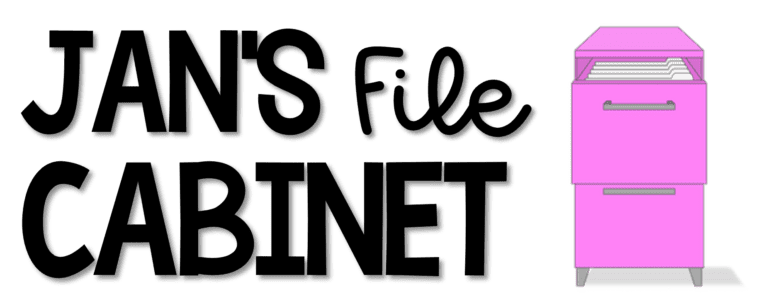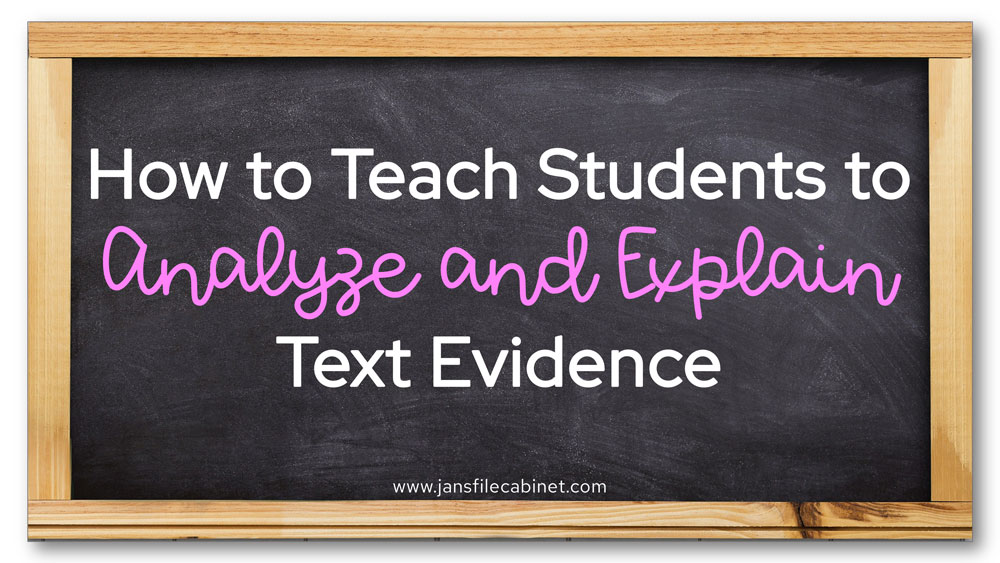Learn strategies to help your intermediate and middle school students analyze and explain text evidence with RACES, TIQAC, or any other acronym you use.
If you teach explanatory writing, you know how difficult it can be for students to analyze text evidence and explain it in their own words. Teaching them strategies can help.
Text evidence consists of words, phrases, or sentences taken directly from a reading passage; a writer uses them to support ideas, opinions, and arguments in their own writing. They are also known as direct quotations.
Upper intermediate and middle school students are typically expected to provide text evidence in short answer responses and formal essays. Once they provide the evidence, they are expected to analyze and explain it in their own words.
Table of Contents
ToggleExplaining Text Evidence Example Paragraph
When explaining text evidence, I require students to include at least three sentences in the analysis/ explanation portion of their paragraphs. The sentence following the evidence should clarify what the text evidence shows or proves. The next two sentences should explain the evidence and expand on it by providing more detail.
Below is an example of a complete paragraph with text evidence and an effective analysis/ explanation. (The text evidence is between the quotation marks, and the analysis/ explanation is in bold.)
Writing Prompt:
Dorothy discovers a rusted tin woodsman while traveling through the forest. Based on her response, identify and explain one character trait that describes Dorothy. Make sure to include evidence from the text in your response.
Example Response:
Based on her response, one character trait that describes Dorothy is compassionate because she feels pity for the tin man. In the excerpt from The Wonderful Wizard of Oz by L. Frank Baum it states, “...for she was moved by the sad voice in which the man spoke.” This quote shows that Dorothy is compassionate because when she hears the tin man speak, it affects her and compels her to take action. When the tin man explains that he is rusty and asks her to oil his joints, Dorothy immediately runs to the cottage to get the oil-can. She rushes back quickly and asks him which joints need to be oiled, which shows she is eager to help him. Therefore, compassionate is one character trait that can be used to describe Dorothy.
I have used this with the RACES and TIQAC writing formats, but it works well with any format that requires students to analyze and explain text evidence.
Four Strategies to Help Analyze and Explain Text Evidence
Use one of the following strategies to explain a piece of text evidence and expand upon it with additional details. This will create the analysis/ explanation portion of the paragraph.
- Give context for the evidence.
- Read around the evidence and paraphrase the supporting points.
- Read around the evidence and make an inference.
- Break the piece of evidence down into smaller parts.
Not all of these strategies will work with every text. It depends on the type of passage (fiction, nonfiction, poetry) and the information it provides. It is a good idea to model how and when each strategy can be used. Also, it is essential to ensure students have enough guided and independent practice with each strategy.
Let’s look at each strategy in detail.

Strategy 1: Give context for the evidence.
Consider the 5 Ws and H (who, what, when, where, why, how) and provide those details in the analysis/ explanation. Who stated the evidence? What was the narrator’s or the author’s point? When was this event happening? Where was it happening? Why did the person state this? How does this relate to the main idea of your paragraph?
Prompt:
Describe how Nag affects the plot of "Rikki-Tikki Tavi" by Rudyard Kipling. Provide one piece of evidence in your response.
Example:
Nag affects the plot of the story by creating conflict. In "Rikki-Tikki-Tavi" Darzee states, “‘One of our babies fell out of the nest yesterday and Nag ate him.’” This evidence shows that Nag, a cobra, is an antagonist who creates problems for Darzee, a tailorbird who lives in a garden in India in the 19th century. In addition, Nag also creates conflict for a mongoose named Rikki-Tikki-Tavi and the human family he protects. Nag and another cobra plan to attack the family and take over the garden, but Rikki defends the family and saves the garden. Therefore, Nag helps drive the plot with the conflict he creates.
Strategy 2: Read around the evidence and paraphrase the supporting points.
Paraphrasing means putting the author’s text in your own words. To paraphrase the original text, you can flip the sentence, rearrange the order of the words, and substitute words with better synonyms. Clarify what the author said so the reader can understand the text evidence in a different way.
Prompt:
Explain how virtual reality is changing people’s lives. Cite one piece of evidence in your response.
Example:
Virtual reality is changing people's lives by allowing them to participate in activities around the world without actually traveling there. In “Welcome to Tomorrow!” by Readworks it states, “Google Earth lets you soar above cities all over the world and “walk” their streets. You can check out distant destinations, explore your own neighborhood, or try theBlu:Whale Encounter by WeVR and feel as if you're swimming in the depths of the ocean.” This quote illustrates how virtual reality helps people explore different places worldwide from the comfort of their own homes. For example, the author mentions visiting cities and "sightseeing" with Google Earth. The author also mentions swimming in the deepest parts of the ocean through a virtual experience called theBlu by a company named WeVR. Both examples show how virtual reality helps people explore hidden parts of the world and participate in exciting and unusual activities. Without having to travel, people can participate in activities around the world through virtual reality.
Strategy 3: Read around the evidence and make an inference.
An inference is an educated guess based on hints in the text. If something is unclear in the original text, make an inference to help fill in the gaps for the reader. What do you think the author means? Why is this important? How does this relate to the main idea of your paragraph? (Even though you are providing personal insights, remember to keep it in the 3rd person point of view.)
Prompt:
Alice sees an unusual rabbit while sitting on the river bank one day. Analyze how Alice responds when she sees the rabbit. Make sure to provide text evidence in your response.
Example:
When Alice sees the rabbit, she responds with shock and curiosity. In the excerpt from Alice’s Adventures in Wonderland by Lewis Carroll it states, “Alice started to her feet, for it flashed across her mind that she had never before seen a rabbit with either a waistcoat-pocket, or a watch to take out of it...” This quote reveals that Alice is startled by a rabbit dressed like a human because she jumps up from where she is sitting on the river bank when she sees it. Alice then chases the rabbit across a field and follows it down a hole without thinking about the consequences. Only people who are curious would do something like that. Therefore, it can be inferred that Alice responds with both shock and curiosity when she sees the rabbit.
Strategy 4: Break the piece of evidence down into smaller parts.
If you have a large piece of text evidence to analyze and explain, break it down and simplify it so the reader can understand each part more clearly. If possible, make each part its own sentence in the analysis/ explanation.
Prompt:
Explain how the Hyperloop is different from other types of transportation. Cite one piece of evidence in your response.
Example:
The Hyperloop is different from other types of transportation because it is superior. According to “Could the Futuristic Traveling Tube Become a Reality?” by Readworks it states, “‘The system I have in mind… can never crash, is immune to weather, it goes three or four times faster than the bullet train… it goes an average speed of twice what an aircraft would do…”’ This evidence shows how the Hyperloop is more superior than other types of transportation. For example, cars, trains, and airplanes can all crash, but this is not true for the Hyperloop. In addition, the Hyperloop can be used in all types of weather and seasonal conditions, so it is usable year-round. Finally, the Hyperloop can transport people more quickly than bullet trains and aircraft, which are currently the fastest forms of transportation. Therefore, the superiority of the Hyperloop makes it different from other types of transportation.
You can access a FREE editable copy of How to Analyze Text Evidence and many other goodies in my FREE RESOURCE LIBRARY by joining my email list with the form below.
Sentence Starters to Help Explain Text Evidence
In addition to teaching students the four strategies to explain text evidence, you can also provide them with sentence starters. These phrases offer scaffolding for students who are overwhelmed with how to start their analysis/ explanation.
Some students overuse these phrases, which can make their writing sound repetitive and formulaic. If this happens, students should delete some of the phrases when they revise their writing.
Sentence starters that help scaffold the analysis/ explanation:
- This quote shows
- This quote proves
- The author writes
- According to the author,
- The author believes
- The narrator states,
- This character shows
- This dialogue illustrates
- In other words,
- What this means is
- This evidence reveals
Words and Phrases that Help Expand Sentences in the Analysis
Another aspect of writing that students tend to struggle with is sentence expansion. This is an essential skill because, according to most state writing rubrics, the bulk of the paragraph or essay should be the student’s own original writing. Students are also expected to vary the length and structure of their sentences.
To bulk up their original writing, students can lengthen their sentences by adding “, which means” and “because.” They can also expand the analysis by adding an entire sentence that provides an example.
Add the phrase “, which means” to expand a sentence.
- Add this phrase to a sentence to clarify the meaning of a word or phrase.
- Add a comma to the sentence before the phrase.
Example: In the excerpt from Boy's Life by Robert McCammon, the narrator states that talking to his teacher gives him a disconcerting feeling, which means he feels disturbed or uneasy.
Add the word “because” to expand a sentence.
- Add this word to a sentence to connect an idea with a cause or reason.
- Do not add a comma.
Example: In the excerpt from Boy's Life by Robert McCammon, the narrator has a disconcerting feeling because his teacher was talking to him about participating in a writing contest.
Add a sentence that begins with “For example,” to expand the analysis.
- Start a new sentence with this phrase to cite a specific case or event.
- Add a comma to the sentence after the phrase.
Example: In the excerpt from Boy's Life by Robert McCammon, the narrator feels uneasy when his teachers talk to him like a regular person. For example, he states that he has a disconcerting feeling when Mrs. Neville talked to him about participating in a writing contest.
Our intermediate and middle school students may find it challenging to analyze and explain text evidence in their writing. These strategies can help them master this skill regardless of the writing format so they become proficient, independent writers.
If you don’t want to miss my upcoming blog posts, join my email list. By signing up, you’ll also receive exclusive freebies!



